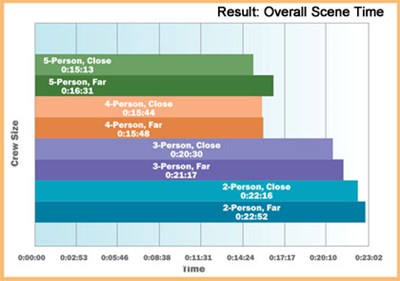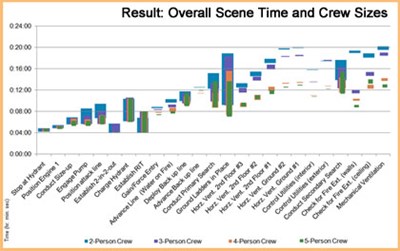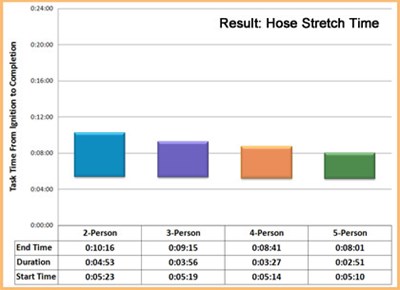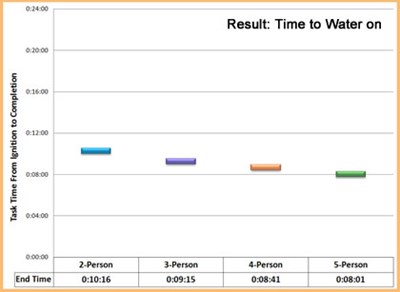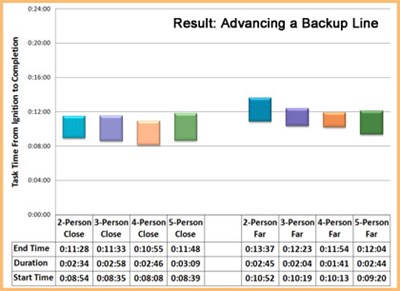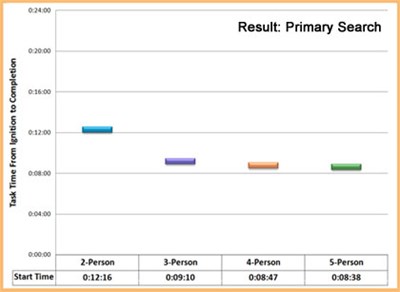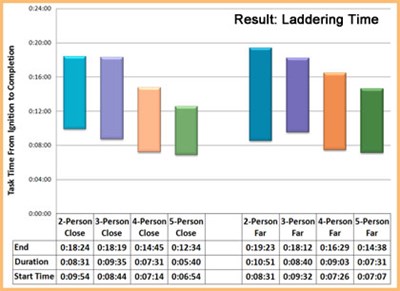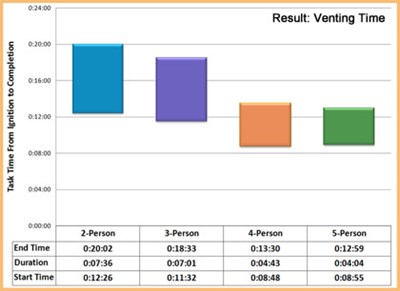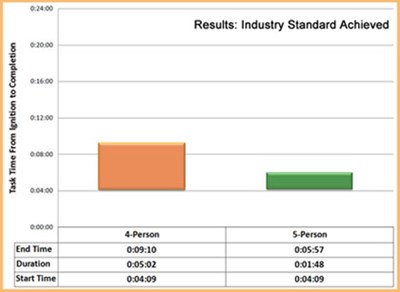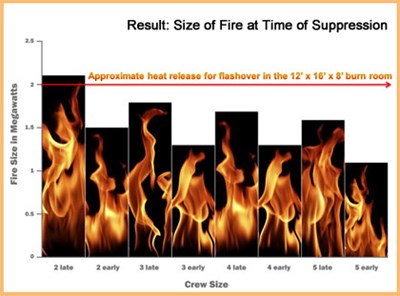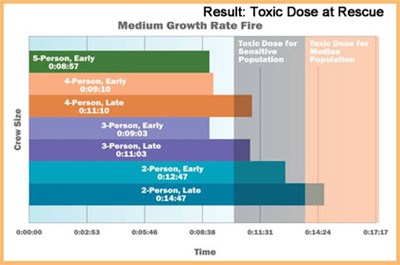The four-person crews operating on a low-hazard structure fire completed the same number of tasks on the fireground (on average) 7 minutes faster than the two-person crews. The four-person crews completed the same number of fireground tasks (on average) 5.1 minutes faster than the three-person crew. The four-person crews were able to complete necessary fireground tasks on a low-hazard residential structure fire nearly 30 % faster than the two-person crews and nearly 25 % faster than the three-person crews. Although on the low-hazard residential structure fire, adding a fifth person to the crews did not show any additional decrease in fireground task times, the benefits of a five-person vs. a four-person crew are significant in other measurements, particularly the “water-on-fire” time. Additionally, the greater need for five-person crews for medium- and high-hazard structures, particularly in urban settings, has been documented in other studies.
This graph shows average times for each task by crew size overlaid for comparison. The five-person crew results are shown in green, the four-person crew results are shown in orange, the three-person crew results are shown in purple, and two-person crew results are shown in blue.
This graph measures the interval from the start of the task “Position Attack Line” to the end of the task “Advance Attack Line.” In comparing four- and five-person crews to two and three-person crews collectively, the time difference for this measure was statistically significant at 76 seconds (1 minute 16 seconds). In conducting more specific analysis comparing all crew sizes to a two-person crew the differences are more distinct. A two-person crew took 57 seconds longer than a three-person crew to stretch a line. A two-person crew took 87 seconds longer than a four-person crew to complete the same task. Finally, the most notable comparison was between a two-person crew and a five-person crew, with a 122-second difference in task completion time.
There was a 10% difference in the “water on fire” time between the two- and three-person crews. There was an additional 6% difference in the “water on fire” time between the three- and four-person crews. (i.e., four-person crews put water on the fire 16% faster than two person crews). There was an additional 6% difference in the “water on fire” time between the four- and five-person crews (i.e. five-person crews put water on the fire 22% faster than two-person crews).
Advancing a backup line to the door and stairwell was started 16 % faster and completed 9% faster for replicates with shorter staggers between company arrivals. Advancing a backup line is typically a task completed by the third arriving engine on a full alarm assignment and is critical to the safety of firefighters already in the building on the initial attack line. For this task, stagger of arrival was statistically significant and is an important consideration for overall station location and full alarm response capability. The differences can be seen in the graph above, which shows the time from the start for the task “Deploy Backup Line” to the end of the task “Advance Backup Line.”
The graph summarizes the times that crews took to start the primary search. On the low-hazard, two-story single-family dwelling 2,000 sq ft (186 m2) , the three-person crew started a primary search/rescue more than 25% faster than the two-person crew. In the same structure, the four- and five-person crews started a primary search 6% faster than the three-person crews and 30% faster than the two-person crew. Note that there is no end time included in this graph. Primary search end times were reliant upon radio communication by firefighters inside the structure. On occasion this communication did not occur or was delayed. Therefore data reliability was insufficient for analysis of task duration and end time.
A four-person crew operating on a low-hazard structure fire completed laddering and ventilation (for life safety and rescue) 30% faster than a two-person crew and 25% faster than a three-person crew. Ground laddering time started with the removal of the first ladder from the truck and stopped at end time of the last ladder put in place. A total of four ladders were raised on each experiment. Truck operations ventilation time is the time from the start time of ventilation of the first window until the last window ventilation was complete. The differences in start times and duration of the tasks can be seen in the two graphs above.
NFPA 1710 requires that a fire department have the capability to deploy an initial full-alarm assignment to a scene within eight-minutes (480 seconds). The number of people required falls between 15 and 17, depending on whether an aerial apparatus is used, and/or if two engines are being used to provide a continuous water supply. In these experiments, the measurement for an effective response force assembly time started from the first engine arrival at the hydrant and ended when 15 firefighters were assembled on scene. This table reveals the differences in assembly times between the four and five-person crews. An effective response force was assembled by the five-person crews a full three minutes faster than the four-person crews. It is important to note that (by definition), the two-and three-person crews were unable to meet this standard at any time during the experiments.
During fire modeling, the investigators examined a medium growth rate fire because the modeling time very closely matched times from experiments. If a fire is not suppressed before full-room involvement, the probability of spread beyond the room of origin increases dramatically if there is nearby fuel load to support fire spread.
- A fire growing at a slow rate will reach 1 MW in 10 minutes and 2 MW in just over 14 minutes. A fire growing at a medium rate will reach 1 MW in 5 minutes and 2 MW in just over 7 minutes.
- A fire growing at a fast rate will reach 1 MW in 2.5 minutes and 2 MW in just over 3.5 minutes.
- Based on fire modeling, it is likely that medium- and fast-growth rate fires will move beyond the room of origin prior to the arrival of fire fighters for all crew sizes.
Fractional Effective Dose (FED) is a probabilistic estimate of the effects of toxic gases on humans exposed to fire effluent. The table above shows the FED for slow-, medium-, and fast-growth rate fires correlated to rescue times based on crew size and arrival time in the study. As with the room-and-contents fire in part 3, results in this table included only the close-stagger rescue time data. The effect of far-stagger rescue times on occupant tenability should be investigated in future studies. Values above 0.3 are shown in yellow, and those above the median incapacitating exposure of 1.0 are shown in red.
The occupant exposure to toxic gases was assumed to occur until the occupant is rescued by the truck crew (start time of primary search plus one minute). Occupant exposures were calculated for both early arrival to the scene, representing crews from fire stations nearby the burning structure, and late arrival, representing crews arriving from more distant locations.
- The simulations showed that for a medium-growth fire, two-person crews would not be expected to complete essential tasks in time to rescue occupants from exposures to toxic gases that would incapacitate sensitive populations such as children and the elderly.
- Two-person crews arriving later would also likely find a significant portion of the general public incapacitated by the time of rescue.
- The simulations for early arriving five-, four- and three-person crews show that they would likely be able to locate and rescue an occupant before sensitive populations would be incapacitated. The calculations considered only close stagger time. However, it stands to reason there would be a greater time gap in far stagger time situations.
- None of the late arriving two-, three- and four-person crews would reach sensitive populations before they were exposed to incapacitating levels of toxins.
[vc_single_image image=”49275″ img_size=”full”]
